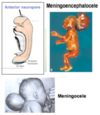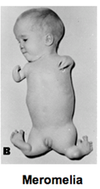LEC-3 MSK Embryology Flashcards
The mesoderm for the skeletal system comes from what two sources?
- Paraxial mesoderm
- Parietal mesoderm
The skeletal system is formed from what two embryonic tissues?
- Mesoderm tissue
- Neural crest tissue
Somitomeres and somites are formed from which mesoderm?
Paraxial
Which mesoderm becomes fused to the body wall once folding of the embryo occurs?
Parietal
What two signal transduction pathways regulate the differentiation of mesenchymal cells into sclerotome, or cells that form the vertebral arch?
- SHH (Sonic Hedgehog)
- Noggin

Cells at the ____________ and _____________ tips of a developing somite differentiate into precursor muscle cells, known as the _________.
- Dorsomedial and ventrolateral.
- Myotome

Cells intervening between the ventrolateral and dorsomedial tips of the developing somite differentiate into precursor skin cells known as the ______________.
Dermatome

_________ and _________ are two key encoding genes that produce proteins vital for muscle differentiation in developing embryos.
MyoD and MYF5
In general, what forms the face and part of the skull?
Neural crest

In general, what forms the axial skeleton from somites and part of the skull from somitomeres and occipital somites?
Paraxial mesoderm

In general, what forms the limbs, sternum, and the pelvic and shoulder girdles?
Parietal mesoderm (body wall)

What are somitomeres and somites?
The segmentally arranged clusters of cells derived from mesoderm and located along the axis of the developing embryo
(Somites/Somitomeres) are located from the occipital region to the coccyx in the developing embryo. They are small and tightly organized.
Somites
(Somites/Somitomeres) are located in the head region of the developing embryo. They are large and loosely organized.
Somitomeres
The vault of the skull refers to the (chondrocranium/membranous neurocranium/viscerocranium).
Membranous neurocranium
Through what method is the neurocranium formed?
Formed through direct intramembranous ossification (meaning cartilage is not present during ossification).

The face refers to the (chondrocranium/membranous neurocranium/viscerocranium).
Viscerocranium
Through what method is the viscerocranium formed?
Formed by endochondrial ossification (meaning cartilage is present during ossification) AND intramembranous ossification (meaning cartilage is not present during ossification)
The base of the skull refers to the (chondrocranium/membranous neurocranium/viscerocranium).
Chondrocranium
Through what method is the chondrocranium formed?
Formed by endochondrial ossification (meaning cartilage is present during ossification).
Identify which of the following structures are derived from the neural crest.

Neural crest structures are shown in blue.

Identify which of the following structures are derived from the paraxial mesoderm.

Paraxial mesoderm structures are shown in red.

Identify which of the following structures are derived from the parietal mesoderm.

Parietal mesoderm structures are shown in yellow.

Identify which of the following structures are derived from the paraxial mesoderm.

Paraxial mesoderm structures are shown in red.
- Base of skull = Chondrocranium

Identify which of the following structures are derived from the neural crest.

Neural crest structures are shown in blue.

(T/F) The membranous neurocranium is derived from mesenchyme that originates from the neural crest and paraxial mesoderm. Its bone is formed as mesenchyme first differentiates into hyaline cartilage. Blood vessels then invade the cartilage, allowing osteoblasts to differentiate and form the bone.
False. The neurocranium is formed from intramembranous ossification. The process described was endochondrial ossification. Neurocranium is formed from mesenchyme differentiating directly into bone. Bony spicules begin to grow outward from a primary ossification site toward the periphery. Bone growth is then continued by appositional (layering) addition of bone on the outer surface and osteoclast resorption from the inside.
Describe endochondrial ossification.
- Surrounding mesenchyme differentiates into hyaline cartilage, forming an “outline”.
- Blood vessels invade the cartilage.
- Osteoblasts differentiate in the area and form bone.
Describe intramembranous ossification.
- Mesenchyme differentiates into primary ossification center.
- Bony spicules grow from primary ossification center towards periphery.
- Bone growth is continued through appositional addition of new layer on outer surface and osteoclast resorption from inside.
What type of ossification forms most bones in the face?
Endochondrial ossification
What type of ossification forms the mandible?
Intramembranous ossification
What are the first bones to fully ossify in the head?
Ossicles (malleus, incus, and stapes)
___________ are narrow seams of connective tissue between two bones.
Sutures
What suture is derived from the paraxial mesoderm?
Coronal

What suture is derived from the neural crest?
Sagittal

























